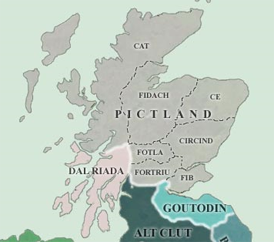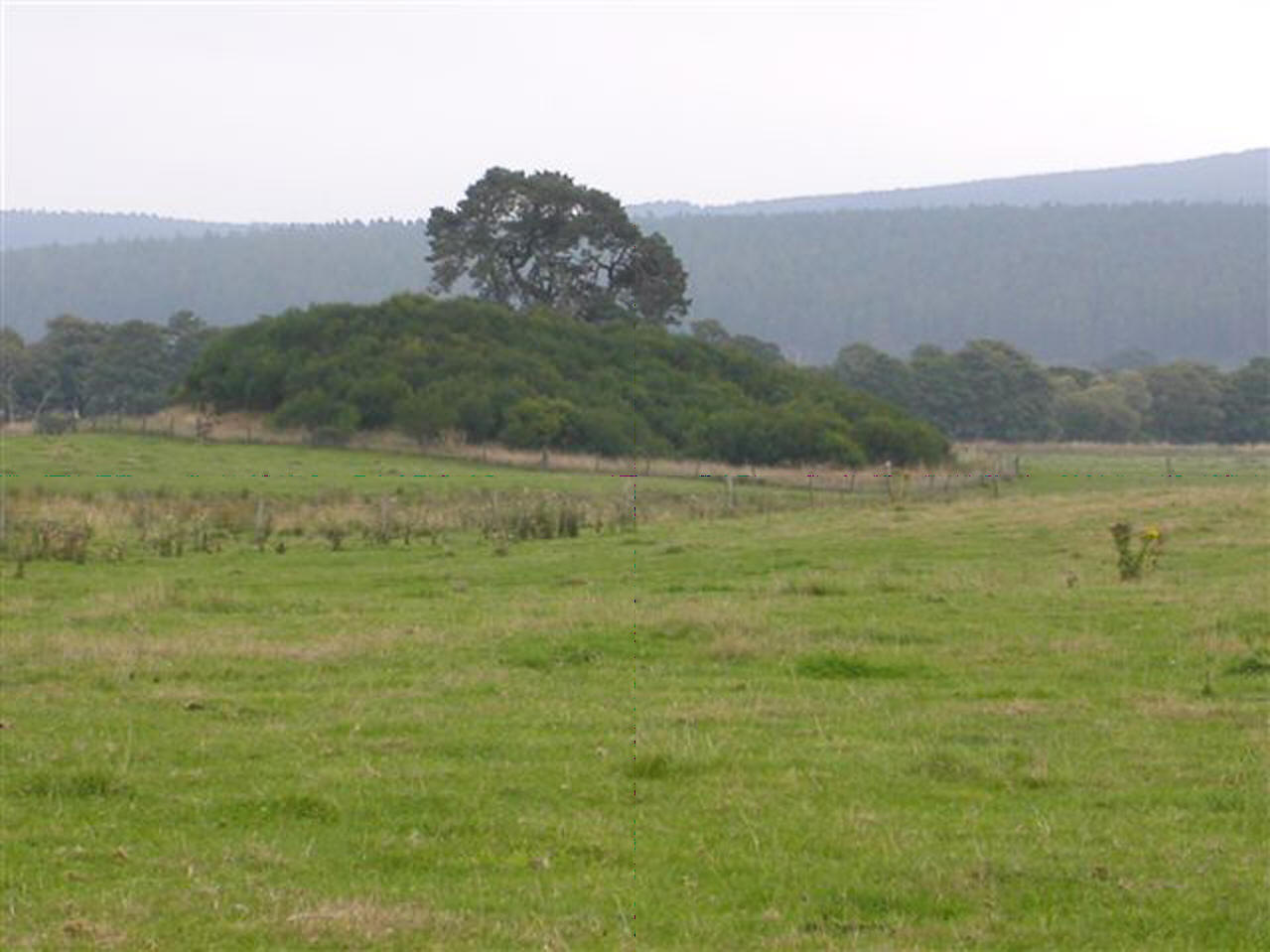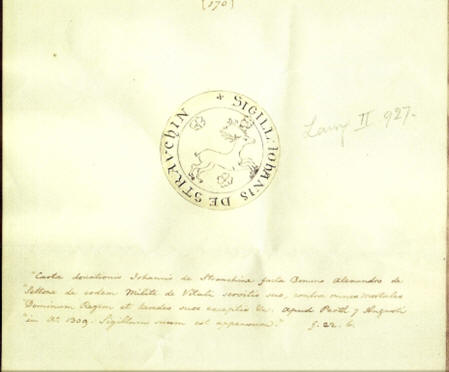History of Clan Strachan
Jim Strachan, MBA, FSAScot
17 February 2024

Map of Pictland
Strachan is a place name. The parish is situated on the southern bank of the River Dee, which was the northern boarder of the Pictish Kingdom of Cincind.
The first recorded use of Strachan (spelling broadly defined) was between c 1189x95, when King William I ('the Lion') granted the barony of Strachan to William Gifford (RRS, ii, no 340). Like the Gifford family, the 'de Strachan' family were of Norman descent, and with a moderate to high probability descendant from a cadet line of the Lords of Morham, who held lands in both East Lothian (near Yester Castle) and Angus, near Arbroath Abbey.
The first use as a territorial designation, was between c1203x13, probably by 20 May 1212, when Ranulpho de Stratheuchin witnessed a charter of Thomas de Lundie concerning the Wood of Trustach in Banchory parish (Arbroath Liber, i, no. 65).
In c 1230, Waltheof of Strachan granted to the Priory of St. Andrews permission to hunt and cut wood in the barony of Strachan in order to build a church and a new hall within the parish. The placenames within this charter confirm that Waltheof held control of an area at least the size of the modern village of Strachan (St. Andrews Liber, 276-7; and Ash, St Andrews, Appendix 7, no. 2, pg 241).
On 16 June 1242, the Church of the Blessed Virgin Mary in Strachan was consecrated by the bishop of St. Andrews, David de Bernham. The church in Strachan was endowed to the Diocese of Brechin. The benefice was granted to the serving Archdeacon of Brechin, signifying the importance of the parish, and was almost certainly constructed by Waltheof de Strachan. (Early Sources, ii: 520, 522/span>; and Ash, St Andrews, App. 2, pg 332)
In 1244, Freeholders in the earldom of Dunbar, and family of the earl, including Waltheof of Strachan, are listed as jurors of Earl Patrick ( CDS, i, nos. 2671, 2672; and Hamilton, 2003: 210-11).

Motte, Castlehill of Strachan
Castlehill of Strachan was a timber fortification built c 1250. Castlehill was the stronghold of the Strachan family, and served as a centre of local administration (Yeoman, 1984). Castlehill was almost certainly constructed by Ranulf of Strachan, Waltheof's son and heir. Ranulf of Strachan was with a high probability a kinsman of Elizabeth de Quincy, wife of Alexander Comyn, the earl of Buchan (CDS, i, no. 2509 , and CDS, i, no. 2513). Ranulf also succeeded the Earl of Buchan as Sheriff of Banff ( ER,. i, clxxviii, clxxx, and 15).
During the War of Independence, the Strachan family sided with the Comyns after Robert de Bruce murdered Red Comyn of Badenoch at the high altar of Greyfriars Abbey.
During the early summer of 1308, following the Battle of Inverurie, forces loyalty to Robert de Bruce burned out and destroyed Castlehill of Strachan (Yeoman, 1984).
On 9 August 1309, John de Strachan granted a charter of donation to Sir Alexander Seton at Perth. Seton was with a high probability a cousin of John of Strachan, and Perth was an English garrison town and a key supply base (Laing, ii, no. 927).

1309 Seal of John de Strachan
Reproduced by permission of the National Archives of
Scotland,
Hutton's Sigilla, Papers of the Society
of Antiquaries of Scotland, GD103/2/15
Five years later, 24 June 1314, was the Battle of Bannockburn. Most medieval battles lasted only a few hours. The Battle of Bannockburn is unique in that it last two days. After the first day of battle, Sir Alexander Seton defected to the Scottish side informing Robert de Bruce of the poor English morale and encouraging the Bruce to continue the attack. It is unlikely Seton alone defected, but likely took his followers including the Strachan Family. King Robert I heeded Seton's advise, and won the battle, driving the English out of Scotland, thus defeating the last of his opponents and secured his place on the Scottish throne.
After Bannockburn, on 6 November 1314, an Act of Parliament at Cambuskenneth, Robert de Bruce disinherited all lands and titles from noblemen who died outside the faith and peace of King Robert in the war, or otherwise, those who had not come to his peace and faith. King Robert I would next grant the lands of the disinherited to his faithful followers and supporters.
After the destruction of the barony of Strachan and Castlehill of Strachan, one of Robert de Bruce's first acts of legislation was to disinherit the Strachans from their lands and titles. In 1316, King Robert granted the barony of Strachan to Sir Alexander Fraser (RI, 1-15). Fraser was a faithful follower of the Bruce, a close friend, would eventually marry King Robert's sister, and would later become Chamberlain of Scotland. This grant appears to be a textbook example of a general policy by King Robert I to redistribute lands and titles previously held by those loyal to the Balliol and Comyn cause, and grant these lands to his allies to further cement their loyalty.
At Parliament 26 April, 1315, in Ayr, it would seem that many of the seals belonging to those who had previously disputed the Bruce cause are affixed to charter (RPS, 1315/1). At least 43 noblemen affixed their seals including Ranulphi de Straquhane from Aberdeenshire whose seal is affixed only two positions below Seton.
It is thought Ranulf Strachan was the young heir apparent of John de Strachan. It is likely that Ranulf de Strachan accompanied Seton not only at Bannockburn, and but that the 'de Strachan' family accompanied Alexander Seton on Edward de Bruce's (Robert's brother) ill fated campaign to conquer Ireland from the English. This is the first and last we hear of Ranulf de Strachan, and it is subsequently believed with a very high probability that Ranulf died in Ireland in the service of Edward de Bruce.
The Gifford Paradox
Prior to November 2021, there was much scholarly debate as to whether the Gifford Family held the barony of Strachan, or the 'de Strachan' family.
The Gifford family were ardent supporters of Robert de Bruce, and their stronghold was the barony and castle of Yester in Lothian (RRS, ii, no. 48; and NGR NT 5563 6668). After the Scots defeat at the battle of Falkirk, Yester fell to the English. On 25 September 1298, King Edward I disinherited the Gifford family and granted the barony and castle of Yester to Adam of Welles from Lincolnshire (NRS GD45/27/141). Yester was later in the war re-taken by Robert de Bruce, who restored the barony and castle of Yester to the Gifford family (Canmore, 'Yester Castle And Goblin Ha').
This leads to the paradox, why would King Robert I destroy Castlehill of Strachan and disinherit the barony of Strachan from the Gifford family; while concurrently restoring the barony and castle of Yester? The only logical explanation for this contradiction is that the Gifford family were not the baronial freeholders of Strachan. Instead, it is clear the 'de Strachan' family held the barony of Strachan, were staunch supporters of the Balliol and Comyn cause, which is why Robert de Bruce disinherited the barony of Strachan.
In November 2021, an article (Strachan, et al.) about a 'Strachan' seal matrix was published in the Tayside and Fife Archaeological Journal. This article was a rebuttal to an earlier 2005 claim by the National Museums of Scotland that a seal matrix discovered in 2001 belonged to John of Strathearn (Hall, et al., TAFAJ, vol. 11). The article published in 2021 underwent a double-blind peer review, and one of the points of contention was who held the barony of Strachan. After providing the aforementioned research, the argument was settled, and subsequently printed.
Learn More: Strachan, JA, and Strachan, G. House and Barony of Strachan: A Study of Lost Causes,ISBN 9781312979598 (2021).